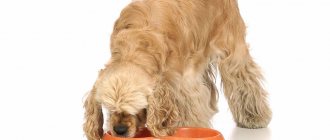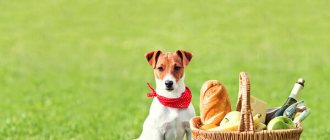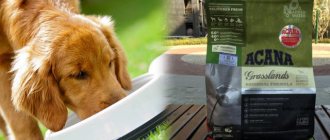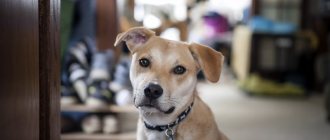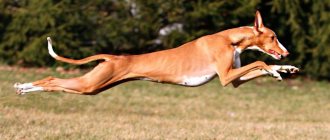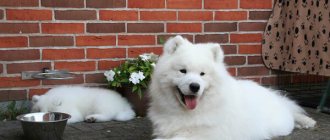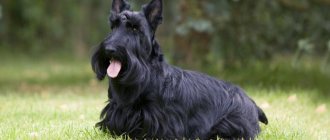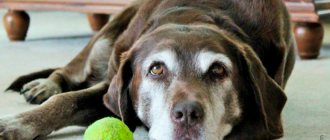Dachshund nutritional features
The dachshund is a hunting breed whose diet relies on meat. Now these are just lap dogs, but they still need a diet in which the proportion of high-quality animal food will be greater than plant food, which the dog’s stomach does not digest well. This is the main condition for proper nutrition of dogs. If this is observed, it is easier to decide whether to feed your dachshund dry or natural. Natural food usually inspires more confidence among owners, but requires counting the amount of nutrients, calories, portion size, and preparation time. The industrial diet is already balanced and easy to use.
Theoretical aspects
Authoritative sources tirelessly insist that it is difficult for a dog to choose a balanced diet. The dachshund, prone to obesity and food allergies, seems to be such a problematic and painful creature... that many owners prefer to choose another breed rather than take risks. In fact, everything is not so complicated, of course, the Dachshund menu requires attention, and its compilation requires some knowledge.
All Dachshunds have dwarfism. Short legs, elongated body, deep chest indicates a gene mutation. This physique is a breed trait and nothing can be done about it. Dogs living with the dwarfism gene need specific feeding according to their age (we will look at this in more detail below).
Further, all dogs are carnivores and they are supposed to eat meat, that is, a natural product. Many breeders claim that the optimal method of feeding is industrial products. So which is better? Definitely straight, but there are nuances here too.
The Dachshund's natural diet should include meat (not fatty trimmings), a small amount of offal, milk (at least in childhood), cereals, vegetables, fruits, oils and vitamins. Store-bought products can hardly be called natural, so the owner has to look for “eco-products.” Of course, you can buy meat and milk at the market, but only if the products have passed veterinary control. There is also a list of products that pose a real danger to your pet’s health:
- Bones, especially tubular ones.
- Leftover food from the table.
- Spoiled products.
- Sugar in any form and its substitutes.
- Xylitol.
- Chocolate and its “analogues”.
- Spices, smoked meats, marinades, large amounts of salt.
- Pasta , baked and any products containing yeast bacteria.
- Grapes, raisins.
If the owner physically does not have time to search, check, and purchase suitable natural products, then it is definitely better to switch the dog to high-quality dry food. After entering a pet store, the inexperienced owner will be in for another shock - an assortment of industrial food, various “regalia”, advertising gimmicks and bright packaging. Among all the “tinsel”, you need to see the main thing, namely:
- Two quality segments: economy and premium food, super-premium and canvas food. The latter are more expensive, more “natural” and healthier, but as practice shows, a healthy Tasca can eat premium products without any problems.
- Three types: dry, semi-moist and wet food. From cheap to expensive, respectively.
- Ingredients: products must be clearly described in descending order of mass fraction, for example, turkey meat, rice, greens, vitamin A. Products that say: protein mixture, animal fats, grains are a priori not of high quality.
- Dosage table - should be on each pack, taking into account age and weight. Most often, the tables take into account feeding standards for pregnant and lactating bitches.
- Storage method : only in closed packs or food-grade plastic containers (with a lid). The second option is riskier, since dishonest sellers can easily mix expired food with fresh food.
Note! Regarding cheap feed, the position of all experts is clear - it’s better to have a low-quality natural feed than a surrogate made from salts and legume waste.
Feeding dry food
Complete dry food from a proven brand is enough to properly feed your dachshund - with it the dog receives everything it needs for growth and development. Do not add vitamins or minerals to your dog’s prepared diet to avoid causing an overdose.
Single portions of “drying” for a dachshund are usually small: the more digestible the food, the smaller. So, a dachshund needs economy class food ~400 g per day, super premium, holistic food - ~40-180 g (the exact amount depends on weight and activity). In the dog's stomach it increases in volume and swells due to water. Don't worry about your pet going hungry by following the manufacturer's recommendations. Remember, the Dachshund is a dog with a good appetite and will gain excess weight if overfed.
How to choose dry food?
Choose premium food or higher for your dachshund, designed for small breeds. Meat and healthy offal (liver, heart) are first on the list. The protein included in the dry diet of an adult dachshund must be at least 22% (meat 40% and above); the amount of other nutrients depends on this figure. A good “drying” should contain little fat and carbohydrates, which cheap foods cannot “boast” of.
Royal Canin Dachshund for dachshunds over 10 months
Premium food. Takes into account the breed characteristics of adult dachshunds: high need for protein to maintain activity and muscle tone, congenital chondrodystrophy and increased load on the spine, jaw structure and grip method, tendency to obesity.
Profine Adult Small Chicken&Potatoes
Czech super-premium food with chicken (45%), corn, potatoes and seafood. Suitable for regulating dachshund weight, preventing joint diseases. Although it is not holistic, it does contain fruit (dried apple) and herbs (basil, sage, fennel).
Wellness Core Healthy Weight grain-free for small breeds
Low-calorie, vitamin- and protein-enriched holistic food with turkey and chicken. The carbohydrate component is potatoes, the vitamin component is apples, carrots, spinach, broccoli, cranberries, blueberries, tomatoes. Suitable for weight regulation, supporting dog joints.
When should you change food?
Food from different brands, but of the same class, does not differ much. Only the dog’s individual preferences and medical indications matter. If the dachshund refuses the offered food or is allergic to it (“the eyes or ears get wet, the hair falls out not during shedding, the dog scratches the skin”), then replace the food or remove allergenic foods (fish, baked goods, fermented milk, smoked meats).
But only if the reason is this, and not parasites or improper maintenance! Offer your pet a trial amount of a different brand of food. If he eats and everything is fine with health, switch to it within 2-3 weeks. Also gradually change “drying” to natural feeding. Monitor your dog and its health.
Consequences of poor nutrition
A common problem that dog owners go to the vet with is obesity, spinal disc damage, or acanthosis nigricans. Improper nutrition leads to such diseases. Many dog owners have the sin that during the day their pet receives food from the common table and dry dachshund food. Experienced dog owners know that this can lead to weight gain and poor digestion. It is also not recommended to mix dry food with cottage cheese.
From a very early age, the dog should not be overfed; it is necessary to exclude any possibility of snacking. To do this, veterinarians recommend keeping your pet's dishes clean. After the dachshund has eaten and moved away from the bowl, the remaining food should be thrown away. Otherwise, there is a risk of overeating and gaining excess weight.
Natural diet
should contain different foods - sources of protein, fats, carbohydrates, vitamins and minerals. Follow this rule and do not try to greatly diversify your dog’s diet.
Suitable:
- stringy meat (chicken (if there is no allergy), turkey, lamb without fat, beef - in large pieces);
- sea fish, boneless, scalded;
- cereal porridge in water or broth (rice, buckwheat), steamed rolled oats;
- vegetables and fruits (raw, grated or put through a blender, with the exception of cabbage, stew it);
- low-fat fermented milk products (yogurt, cottage cheese; cheese - as a reward);
- tendon bones (clean teeth, strengthen jaw);
- eggs (boiled or raw yolk).
List of permitted and prohibited products
Natural feeding has its own nuances. We must keep in mind what can be given to a dachshund, and what is better left prohibited.
List of approved products:
- Chicken, turkey, rabbit, beef, veal;
- Sea fish without bones;
- By-products (beef tails and tripes, lungs, heart, liver, chicken feet, beef cartilage);
- Cereals – buckwheat and rice. You can add rye or wheat bran;
- Vegetables and fruits (fresh or boiled zucchini, carrots, cucumbers, all types of cabbage, apples);
- Low-fat cottage cheese.
List of prohibited products:
- Salted and smoked;
- Whole milk, cream and butter;
- Pork and lamb;
- Raw river fish;
- Sweet;
- Food from the table;
- Exotic fruits;
- Oatmeal;
- Ground meat;
- Tubular and fish bones.
What not to feed
- pork and other fatty meats (causes vomiting and diarrhea),
- fatty (butter, margarine, fried),
- chicken skin (allergenic),
- pearl barley, semolina, legumes (not digestible), millet (causes diarrhea),
- bones (the intestines are injured, clogged);
- potatoes (exclude or give in small quantities: dachshunds hardly digest starch),
- sweet, salty, hot, spicy, smoked foods (spoils digestion, teeth, detracts from the sense of smell),
- sweet products.
Tips and tricks
Your dachshund must be weighed regularly to determine whether it is overeating or, conversely, starving. The diet is adjusted based on load and age, not forgetting that the maximum weight of a dachshund, as a rule, does not exceed 9 kg.
What can you feed your dachshund?
It is recommended to alternate meat, dairy, fish and vegetarian days. To adjust (or stabilize) weight use:
- beef, beef tripe and pearl barley - for obesity;
- beef, rice, barley, buckwheat - at normal weight;
- beef, sea fish and millet - with a lack of mass.
Food should not only be varied and fresh, but also thick - in the cold, and thinner - in the warm season.
What not to feed your dachshund
Any fermented or cold food is prohibited.
The register of prohibited products includes:
- pork and minced pork, which cause diarrhea;
- raw river/lake fish (to avoid tapeworm infection);
- chicken and rabbit bones;
- sausages and sausage (due to saltpeter leading to cirrhosis of the liver);
- onions and garlic, leading to stomach ulcers;
- sugar and all confectionery products;
- pickles, smoked meats and marinades;
- legumes, including peas, beans and lentils, which cause flatulence;
- baking and baking (due to the high content of baker's yeast);
- grapes, including dried ones.
Make sure that mustard, pepper, vinegar and any hot seasonings do not get into your dog food: they negatively affect the sense of smell and cause kidney disease.
Return to content
What to feed a puppy
Find out from the breeder what food your puppy is accustomed to, and feed him the same for a week or two. This will avoid possible digestive disorders and allergies. The frequency of feeding a baby dachshund depends on its age.
| Age, months | Feeding frequency, once a day | What to feed |
| up to 1 | ~10-12 (every 2 hours) | mother's milk, sour milk, meat broths at room temperature |
| 1-2 | 5-6 | + semi-liquid porridge and pureed vegetables |
| 2-3 | 4 | + cereal soups with vegetables, boiled meat |
| 3-5 | 3-4 | + little by little raw meat, boiled offal, exclude pure milk |
| 3-8 | 3 | gradual transition to an adult diet |
| after 8 | 2 | like an adult dog |
Dachshund puppies go through periods of increased growth during which they need an “adult” portion of food. This is fine. Focus on the puppy's fatness: he should not have noticeable ribs. Underfeeding babies is more dangerous for their health than overfeeding! Malnutrition will not turn him into a dwarf breed, but will make him sick, with a lack of bone mass. But the height will still be the same as that of his parents.
The dachshund puppy wants to go to the toilet immediately after eating, so you need to walk him after feeding, but do not let him run actively.
Some owners advise small puppies to be given meat food for children. But you can also do it yourself by grinding boiled meat in a blender and adding a little porridge. Be sure to give your puppy milk and dairy products up to 3 months, which will provide calcium to his growing skeleton.
Here's an expert's opinion on proper dog nutrition.
Stop menu: products that need to be excluded
https://www.youtube.com/watch?v=clouQ7L1_mw
morning - cottage cheese, boiled egg;
evening - chicken with rice, carrots;
morning - beef with buckwheat, apple;
evening - stewed cabbage with zucchini, fish;
like on Monday;
morning - turkey with steamed rolled oats, cucumber or a piece of watermelon;
evening - beef liver with boiled vegetables;
like Tuesday;
morning - porridge, boiled egg, piece of beef;
evening - curdled milk, chicken, some fruit;
like on Friday.
How and what to feed an adult dachshund
Feed your Dachshund twice a day, morning and evening. A one-time amount of “natural food” is calculated using the formula 40 g * x kg, where x is the weight of the dog. If your dog’s “hungry” look forced you to give him a daytime snack, give him a smaller portion in the evening. But it’s better not to disrupt the feeding schedule. This is the only way the dachshund will not beg and steal food.
Let adult dogs eat after a walk, so as not to provoke intestinal volvulus. Cook meat, grains and vegetables separately from each other, and mix in a bowl before serving. Don’t forget about clean drinking water: the dog should have plenty of it at any time of the day and year (especially in the summer heat). It is not advisable to combine nutrition systems (ready-made and natural).
Here is a detailed example of feeding from their owner.
Nutrition for older dogs
The diet of an elderly dog should be different from the menu of an adult dog. Older pets may begin to refuse food, which is why you will have to look for some way to feed the animal.
It is recommended to reduce the calorie content of portions, since older dogs have a slower metabolism and less physical activity. With the same menu, the pet may gain a lot of weight, or begin to leave a lot of uneaten food in the bowl.
When feeding dry food, it is recommended to purchase another one with a lower protein content.
Attention! Don't forget to weigh your dachshund regularly to monitor changes in your pet's body. The diet should be adjusted depending on the animal’s lifestyle.
Elderly dachshund
Vitamins for dachshunds
Dachshunds are often deficient in phosphorus and calcium, and their skeletal features require active joint protective supplements (glucosamine). Proven complexes for dachshunds:
8in1 Excel Calcium (Calcidee)
Based on the balance of phosphorus, calcium and vitamin D, it combines well with other complexes, in some cases it is recommended to be fed along with dry food. Suitable for puppies, pregnant and lactating bitches.
8in1 Pervinal Excel Puppy Multi Vitamin
A complete complex of 12 vitamins and 10 minerals, suitable for rapidly growing dogs.
8in1 Excel Glucosamine
Chondroprotector, contains glucosamine and chondroitin, which protects the cartilage of the intervertebral joints, as well as the joints of the limbs, from destruction.
Feeding pregnant and lactating bitches
Give puppy and lactating bitches more food from about the second half of pregnancy so that they do not have a deficiency of nutrients, vitamins and microelements. Then increase the frequency of feeding to 4 times a day and maintain the entire period of whelping and feeding the puppies - ~2 months, but no longer. After giving birth, be sure to make sure mommy gets enough minerals, especially calcium, to avoid postpartum eclampsia. After weaning the puppies, the bitch may seem thin - fatten her up a little, but don’t get carried away, and later switch her to super premium and holistic class diet food.
General recommendations
Dachshunds do not suffer from lack of appetite and will eat as long as they are fed . Those who like to beg during the day can have a snack, reducing the evening portion taking into account its calorie content.
The dachshund has high energy requirements compared to large breeds: it requires (weighing 6 kg) 85 kcal per 1 kg, while the Newfoundland (weighing 60 kg) requires only 50 kcal / kg. But the food of an adult animal should not be oversaturated with fats.
A healthy indoor dog eats up to 0.8 liters of food in the form of semi-liquid porridges and thick soups in one meal (with two feedings), and up to 1 liter when kept in an enclosure. The remaining food is removed from the cup. If your dachshund is indifferent to food, you should consult a veterinarian: this may indicate an illness.
Healthy eating rules
Like most dogs, a grown dachshund is fed twice a day (morning and evening), at the same time. Overfeeding is unacceptable: excess weight is bad for health. Only lactating bitches receive more food, since after giving birth they often lose weight sharply.
Adult dachshunds are fed after walking, serving warm food (at room temperature). Food and water bowls are at shoulder level for the dachshund. She drinks about 1.5 liters of water per day.
Unfamiliar foods are introduced gradually, monitoring the dog’s well-being, including appetite, the presence of allergic manifestations and the quality of feces.
Natural nutrition
It should be variegated, with the obligatory presence of carbohydrates, fats and proteins in combination with vitamin supplements.
Meat and offal
The sinewy flesh helps strengthen the jaw and assimilate food: when gnawing rough meat, gastric juice is better released.
The dachshund menu includes:
- beef;
- horse meat;
- chicken;
- turkey meat;
- lamb (lean).
Meat/offal is boiled for 5-10 minutes or given raw, based on the norm: 15-20 grams of pulp per 1 kilogram of weight. Dachshunds are shown tendon bones, which also strengthen the jaws and at the same time clean the teeth.
Important! After feeding the bone and meat, the dachshund is not given anything else that day. And taking into account the slow digestion of bones, the next day’s portion is reduced.
Occasionally, the dog is pampered with boiled sea fish, removing large bones.
Cereals
They, as the main suppliers of carbohydrates, are used for cooking porridge in water (broth). Cereals (buckwheat, rice and rolled oats) are boiled and then combined with a vegetable side dish or meat.
Other products
Vegetables/fruits are responsible for vitamins and fiber, among which potatoes stand apart. Due to the high concentration of starch, it is given little by little and infrequently.
The following are considered more useful for dachshunds:
- carrot;
- tomatoes;
- zucchini;
- cabbage;
- apples.
All products, except white cabbage, are given raw, after being chopped . Cabbage is blanched or stewed. A dachshund cannot live without calcium, which is supplied by yogurt, unsalted cheese and cottage cheese.
The natural diet is enriched with vitamin and mineral complexes, mixing them with food.
Dry and wet food
When choosing dry food, look at the protein content, which should be at least 22%. Before putting your dog on a dry diet, give it intermediate food (with a moist consistency) of the same brand: the dog senses its aroma more keenly. At the same time, check the animal’s reaction to the food - canned food will become its tester.
Important! If there are no side effects, buy dry food, making sure that the size of the granules is suitable for your dachshund’s teeth: often dogs of small breeds ignore excessively large and hard granules.
A package weighing 4 kg will last for 5-6 weeks, but to prevent the food from oxidizing, it is recommended to buy it in smaller containers.
Pedigree feed lines
They are presented in 4 segments: economy, premium, super premium and holistic.
Economy food is devoid of meat (it is replaced by offal), but is stuffed with preservatives and flavor enhancers. These products are produced under the brands Darling, Friskies, Chappi, Cesar, Trapeza, Pedigree, Stout, Our Mark and Oscar.
Premium foods under the brands Brit Premium, Pro Plan, Advance, Hills, Probalance, Royal Canin contain meat, vitamins, and by-products (20-30%).
Dachshunds are recommended to eat at least super-premium food, including Brit Care, 1st Choice, Fitmin, Dukes Farm, Pronature Original, Josera and Monge. They contain meat (up to 45%), no by-products or preservatives.
The most useful are products labeled “holistic” from Acana, Orijen, Grandorf, Savarra, Now Fresh, Canidae and more. This “dry” (and canned food) contains a lot of meat and medicinal plant components for the prevention of canine diseases.
Return to content
What food to feed a dachshund with health problems
- Obesity: if it is not diabetes or thyroid disease, put your pet on a low-calorie natural diet (meat, vegetables and dairy) or a ready-made diet for overweight dogs.
- Allergies: hypoallergenic lines of industrial feed are suitable; or choose those natural products to which your pet will not have a reaction.
- Gastritis: easily digestible foods (chicken), steamed, slimy soups and porridges or food for dogs with sensitive digestion.
Diet adjustments, allergies and other important points
It's no secret that Dachshunds are prone to food allegra and sudden hair loss. If your pet begins to go bald, the first thing to do is review its diet. As practice shows, by optimizing the menu and excluding questionable products from it, hair loss can be stopped. Naturally, when it comes to parasites or pathologies, even the strictest diet will not help.
The next important point is how to help your dog lose weight or gain weight? Dachshunds kept on a natural diet are translated into:
- Barley porridge, beef tripe, beef - for obesity .
- Rice, buckwheat, river, barley and beef - at normal weight.
- Ocean fish, beef and wheat cereals - if you are underweight .
In all three options, do not forget about vegetables, fruits, oils, and vitamins. Dairy products are healthy, but permissible if the dog does not have lactose intolerance.
Important! Do not self-medicate if your dog is actively losing hair! Don't get carried away with vitamins. The causes of baldness are so varied that delaying it can lead to loss of the most valuable thing - time.
Allergy is the most frightening theoretical factor: “The dog will suffer, itch, go bald, and I won’t be able to understand why.” There is some truth in this; identifying the allergen is difficult, but possible. The process will take a lot of time if you feed the dog “natural”. The algorithm is as follows:
- Put your pet on a light diet , for example, rice, broth, zucchini.
- Take a course of antihistamines and make sure that allergy symptoms are completely gone.
- Add a small amount of a new product (a teaspoon, 3-5 grams), for example, a tomato.
- Observe the dog's behavior over the next three days . If there are no suspicious symptoms, the “test” product is introduced into the diet.
This way, you can expand your pet’s menu to 6–8 main products from which you can prepare porridge. An adult Dachshund is indifferent to taste contrasts; on the contrary, many dogs do not like food delicacies.
Let's say you don't have time to identify allergens or your dog has an acute reaction even to neutral food, for example, rice or beef. In this case, you need to choose hypoallergenic dry food for your Dachshund. However, even here you will face difficulties; not everyone, even hypoallergenic food, is suitable for allergy sufferers.
You should not buy large bags of food for testing; it is better to start testing with canned food. Semi-moist food is packaged in small containers and is usually eaten with great pleasure. Once you have selected a suitable semi-moist food, you can try dry food of the same brand and line.
